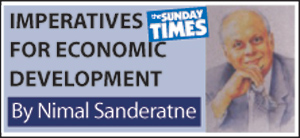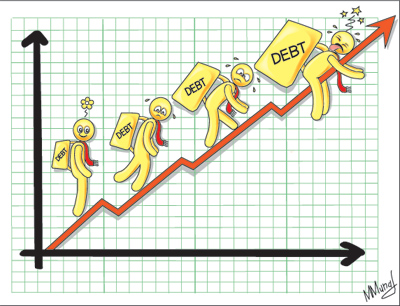Columns
The vicious cycle of public debt and debt servicing cost
View(s):In as much as fiscal deficits over many years have contributed towards the large public debt, the debt servicing costs of the large accumulated debt is an important underlying reason for incurring recurring fiscal deficits. To break this vicious cycle the fiscal deficit must be reduced significantly to below 5 per cent of GDP to bring down the continuing burden of the public debt servicing cost.

Previous columns have pointed out the difficulties of containing the deficit owing to constraints on both the revenue and expenditure sides of the fiscal equation. However difficult the task is, its attainment is vital for economic stability and sustained economic growth and social development. A conviction that this is so should lead to a strong resolve to take meaningful measures to reduce the deficit.
Increasing debt
It is true that the fiscal deficit as a proportion of GDP has shown a declining trend, even though there was an increase in 2012. Yet this declining trend has not been of much avail as the amount of the debt has been increasing — and the debt servicing costs have been rising to such an extent that last year’s revenue was inadequate to meet the debt servicing costs. Consequently further borrowing to meet recurrent and capital expenditure has increased the debt servicing costs.
The reduction of the public debt as a proportion of GDP has not been of much help as revenue collection has fallen as a proportion of GDP. Tax revenue has declined from 14.5 per cent of GDP in 2000 to as low as 11.1 per cent in 2012. It is a curious feature of the Sri Lankan economy and public finances that the revenue to GDP ratio declined when the economy grew faster. Even though the amount of revenue increased, it has declined as a proportion of GDP.
This raises questions about the quality of growth and the calculation and estimates of the growth statistic. Similarly the economic growth of 8.0, 8.2 and 6.4 per cent in the last three years has led to massive trade deficits and increased foreign borrowing to avert balance of payments difficulties.
We are told by authoritative sources that the economy will grow faster this year at 7.3 per cent. It is hoped that this respectable growth rate would lead to increased exports and a reduced trade deficit and that this year’s growth would lower the fiscal deficit brought about by higher revenues, lesser losses in public enterprises and more prudent public expenditure.
This may be too much of an expectation given the past record and the emerging evidence for this year. No doubt the additional expenditure in show casing the country for the CHOGM delegates would be a good excuse for overshooting expenditure and not achieving the fiscal deficit target.
We can only hope that the budget that is being prepared for 2014 will ensure a significant departure to achieve a substantial decline in the fiscal deficit in at least 2014.
Regressive taxation
The unsatisfactory fiscal situation leads to several other detrimental impacts and repercussions. Among these has been the tendency for regressive taxation. Within the last year there have been several taxation measures that have been regressive. Import duties have been levied on several basic items of consumption such as dhal, sugar, wheat flour and milk powder, increasing the burden on poor households.

These taxes thinly disguised as taxes to encourage domestic food production are a threat to food security of poor households and may result in an increase in under-nutrition of a significant proportion of households.
The inadequate expenditure in education and health are further repercussions of the inadequacy of revenue. In brief, the unhealthy state of public finances has led to a distorted prioritisation of public expenditure that would have severe long-term adverse repercussions on sustaining economic growth and social development.
Targets and performance
The importance of containing the fiscal deficit by increasing revenue and pruning expenditure is officially recognised but the budgetary outturns have been off target. Overruns in public expenditure and shortfalls in revenue have been persistent problems over many years. Consequently the development of social infrastructure has been seriously neglected at the cost of the country’s long-run economic and social development.
The implications of the preceding discussion are that the large debt servicing costs are a burden on the poor. Apart from the regressive taxation and the depreciating currency that burdens the poor, the inability of the government to expend required finances for education, health and social services means that the poor would remain poor.
The country’s post independent social transformation has been brought about by expenditure on education and health. The current state of public finances is a serious constraint to advancing the quality of education and maintaining the health of the poor. In addition, the country has reached the fourth phase of the demographic transition of an ageing population.

This means there is a need for higher social expenditure that would improve facilities in hospitals to take care of ailments associated with ageing.
These include geriatric care, higher incidence of heart conditions, diabetes, Alzheimer’s and other infirmities associated with old age. Besides this, there is a need for much higher expenditure for institutional care of the elderly.
The increase in this need is due to both the ageing of the population and the breakdown of the traditional method of caring for the elderly in their homes. The state of the public finances and the prioritisation of expenditure have hardly addressed this emerging social problem.
Summing up
The increasing public debt and its high servicing cost that absorbs the highest amount and proportion of government revenue lead in turn to increasing borrowing that increases future debt servicing costs. Breaking this vicious cycle is vital to achieve economic stability and prioritise government expenditure.
Measures to increase revenue as well as decrease government expenditure on non- productive activities and the reduction of losses in public enterprises are essential to achieve a lowering of the fiscal deficit. The recognition that the large fiscal deficit is the core economic problem should lead to strong resolve to reduce public expenditure. There should be a strong resolve to break the vicious cycle of the public debt that leads to high debt servicing costs that in turn increases the public debt.
comments powered by Disqus
